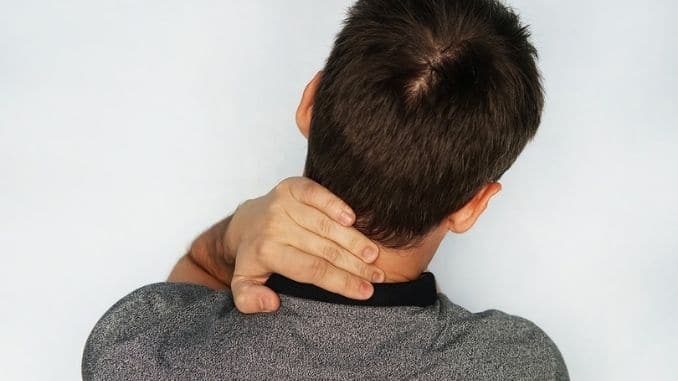
One of our readers asked us about potential lifestyle remedies for cervical dystonia, which is a type of nerve disorder that affects the neck. Although there is no cure for the condition, there are several things you can do to alleviate symptoms and improve your daily life.
What Is Cervical Dystonia?
Also called “spasmodic torticollis,” cervical dystonia is a rare neurological disorder that causes the neck muscles to move when you don’t want them to. These uncontrollable muscle contractions can result in the head twisting or turning to one side or tilting forward or backward.
In some cases, the head moves and then stays there for a moment or the movement continues repeatedly, resembling a tremor or spasm.
Other potential symptoms include:
- Chin moves toward the shoulder (the most common symptom), straight up or straight down
- Ear drops toward the shoulder
- Head jerks to one side or the other
- Head shifts on the shoulder forward or backward
- A combined series of these movements
In some cases, hand tremors or involuntary muscle contractions in nearby areas of the body, such as the face, jaw, arms, and trunk.
Symptoms that get worse with stress or excitement:
- Exhaustion
- Burning pain in the neck and shoulders
- Headaches

Although it can be present at birth, cervical dystonia more often seems to develop between the ages of 30 and 50. Symptoms typically start slowly, showing up in mild forms here and there, and then become worse gradually. Often, the condition develops over one to five years, then plateaus.
In about 10 to 20 percent of the cases, symptoms disappear within five years of beginning. In most cases, they persist for life.
What Causes Cervical Dystonia?
Unfortunately, scientists don’t yet know what causes this condition nor have they found a cure. They do know that it occurs because of a problem in the nerves in the brain, particularly those in the basal ganglia — a group of structures found deep within the cerebral cortex in the outer layer of the brain. Although this area is responsible for several things, including many cognitive and emotional functions, it’s best known for its role in the movement.
Usually, the brain sends messages from the basal ganglia to the muscles so you can move them when you want to. In patients with cervical dystonia, for some reason, improper signals in the nervous system develop, causing muscles to contract involuntarily.
Scientists don’t yet understand what causes this malfunction. They have learned enough to conclude the following:
- In about 10 to 25 percent of cases, it seems to run in families, so there may be a genetic connection.
- Cervical dystonia may be part of generalized dystonia (a muscle movement disorder), which has been associated with the DYT1 gene.
- It may develop as a result of another condition as the use of certain drugs that can damage nerves in the brain (antipsychotics or certain nausea medications) or because of degenerative brain diseases like stroke and Parkinson’s disease.
- In about 10 percent of the reported cases, cervical dystonia is caused by physical trauma.
- Children with cerebral palsy may have secondary dystonia symptoms that include cervical dystonia.
How Is Cervical Dystonia Usually Treated?
Because there is currently no cure for cervical dystonia, treatment focuses on relieving symptoms. No one treatment works for everyone, so doctors usually offer the following. Patients may need to experiment to see which one or combination of treatments works best:
- Botox: You’ve heard of Botox for fading wrinkles. It can also help improve symptoms of cervical dystonia. Doctors inject it into the affected muscles, which can help reduce the number of involuntary movements. In about 70 percent of patients, these injections reduce spasms for up to four months, after which the treatment must be repeated. Unfortunately, over time, the body can develop a tolerance for the drug so that it doesn’t work as well.
- Medications: Oral medications can help about 25 to 33 percent of people with cervical dystonia. These include those with anticholinergic effects ― which help control tremors but can have troublesome side effects ― sedatives, muscle relaxants, and antiseizure drugs.
- Physical therapy: Physical therapy can help temporarily relieve spasms and improve flexibility in the neck area to help reduce pain. Therapists can also help patients identify which movements worsen their spasms and which ones might relieve them.
- Biofeedback: This mind-body therapy uses machines to provide visual and auditory feedback to the patient, helping him or her to learn relaxation techniques that can reduce pain and muscle spasms. In a small 2003 study, both physiotherapy ― which uses heat, massage and physical therapy ― and biofeedback reduced disability and pain, with the effects remaining three to nine months after the end of treatments.
- Surgery: In severe cases where other treatments don’t help, surgical procedures may be used as a last resort. There are two main types: one that cuts the affected nerves so they can no longer transmit incorrect messages, and one that involves deep brain stimulation. Nerve cutting can be effective at stopping the spasms, but it requires a long period of rehabilitation and can cause lasting side effects.
In a 2012 study, researchers divided 40 patients with cervical dystonia into two groups: one group that received Botox and physical therapy and another group that received Botox only. Although both groups showed significant improvements in the severity of the condition, only those undergoing physical therapy experienced improvements in pain and disability.
Deep brain stimulation involves placing electrodes (thin wires) into the brain on both sides that are connected to stimulators that send small electrical pulses into the brain. These pulses seem to help improve the dystonic movements.
Tips for Easing Cervical Dystonia Symptoms
People with cervical dystonia can go on to live full, productive lives, but they will need to engage in regular types of therapy and treatment to control their symptoms. Below are options for exercises and other lifestyle therapies that can help. Always check with a qualified physiotherapist before trying any exercises.
1. Make Sure You’re Getting the Nutrients You Need
Some forms of dystonia can make eating difficult, which can lead to an inadequate diet. Yet, good nutrition is critical for health, so it may be necessary to work with a dietician. He or she can suggest texture-modified diets, foods that are easier to eat despite the spasms and nutritional supplement drinks.
2. Manage Stress
Stress makes the symptoms of this disorder worse, so it’s best to practice a stress-relieving activity every day. Good options include meditation, guided imagery ― like taking a vacation in your mind ― deep breathing, a daily walk, aromatherapy, a daily gratitude journal and time spent with supportive others.
Don’t forget to cut out those things in your life that may be contributing to high levels of stress. Some common examples include watching the news frequently, spending too much time on social media, drinking alcohol or consuming too much caffeine.
3. Try Acupuncture or Massage
We have limited information on how these therapies may affect cervical dystonia, but what we do have is positive. Both can not only help you relax and relieve stress, but they may also relieve the pain that often accompanies this condition.
Be sure to see a qualified practitioner — one who has experience treating this condition. A massage therapist may use techniques like myofascial release, deep tissue massage and assist stretching to help address muscle tension and release pain.
A recent small study on acupuncture ― involving only five patients ― showed that acupuncture could help relieve symptoms, with all participants reporting improvement.
4. Find Your ‘Trigger Spots’
Many of those living with cervical dystonia have “trigger spots” — areas they can touch that will help the head return to its normal position. Also called “sensory tricks,” they are maneuvers that can alleviate a contraction.
An analysis of videos of 138 participants in the Dystonia Coalition research project confirmed that these sorts of tricks, such as applying a light touch to the affected part of the body or an area nearby, were partially effective at relieving the spasm in 43 percent of participants and completely effective in 40 percent.
When the muscle contracts, try one of these to see if you can get it to relax:
- Raise one arm and place a finger near the dystonic muscles (the ones contracting)
- Push the chin or forehead in the opposite direction of the contraction
- Touch the lower face, the chin or the back of the neck with one finger lightly
Once you find your spot and start using it, you may find that simply thinking about making the movement can cause the head to return to its normal position.
5. Join a Cervical Dystonia Support Group
Because of the difficulties that this condition presents, particularly in social situations, it’s important to be able to talk to other people who understand. Ask your doctor about support groups in your area. If there are none, you may be able to start one yourself.
The Dystonia Foundation has an online support group as well as a portal page where you can find others in your area. There are also many groups on Facebook and some on Yahoo.
6. Exercises to Try
Start by warming up the area with a hot towel or heating pad for 10 minutes, then begin by moving your chin back toward neutral. You can do this with the heating pad in place. If you can move to neutral, begin to tilt your head away from the spasm side. Expect slow progress, so be patient.
- Head passive movement: Ask a family member, nurse or caretaker to carefully and without too much force move your head to a particular direction — so you’re looking left, for example. Then, ask them to try to move your head in all the directions so that you’re facing right, then looking down and then looking up. This exercise is particularly helpful for those who cannot move their heads by themselves as it can stretch the muscles and help ease tension.
- Head active movement: If you can move your head on your own, try this exercise in front of a mirror. Using your hands, move your head gently in one direction and then another, left and right and then forward and back. If you feel any pain, let up and report it to the doctor.
Practice this movement daily to boost your confidence as to your ability to return your head to its neutral position.
- Body and head straight movement: Many victims of cervical dystocia are so depressed that they don’t realize the inclination of their heads. It’s always best to straighten the head whenever you can rather than to allow it to remain in an unnatural position.
Use a mirror to inspect your posture. Touch your chin and adjust the position of your head. Practice this exercise as many times a day you can. This is effective in x correcting the posture of the neck gradually, helping it to gain more balance.
- Correct posture when sitting: To practice correct posture when sitting, try this: start by standing straight then, as you sit down, try to maintain your body balance. Pull back your head and tuck your chin if your neck falls. This helps the SCM (sternocleidomastoid) muscles to relax.
You can practice this in front of a mirror when no one is around. If you are sitting for a long time somewhere, you can practice doing the same thing. Chin-tucking exercise is one of the most beneficial exercises in cervical dystonia.
For help eliminating your neck pain, make sure to check out Neck Pain Solved, here!
.

